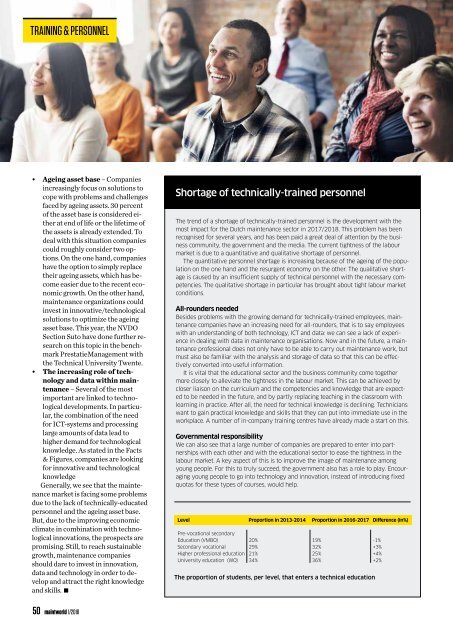Maintworld 1/2018
The Use and Misuse of Vibration Analysis // The Industrial Iot Maturity Model // Condition Monitoring in Maritime Applications // Effective Backlog Management
The Use and Misuse of Vibration Analysis // The Industrial Iot Maturity Model // Condition Monitoring in Maritime Applications // Effective Backlog Management
Create successful ePaper yourself
Turn your PDF publications into a flip-book with our unique Google optimized e-Paper software.
TRAINING ADVERTORIAL & PERSONNEL<br />
• Ageing asset base – Companies<br />
increasingly focus on solutions to<br />
cope with problems and challenges<br />
faced by ageing assets. 30 percent<br />
of the asset base is considered either<br />
at end of life or the lifetime of<br />
the assets is already extended. To<br />
deal with this situation companies<br />
could roughly consider two options.<br />
On the one hand, companies<br />
have the option to simply replace<br />
their ageing assets, which has become<br />
easier due to the recent economic<br />
growth. On the other hand,<br />
maintenance organizations could<br />
invest in innovative/technological<br />
solutions to optimize the ageing<br />
asset base. This year, the NVDO<br />
Section Suto have done further research<br />
on this topic in the benchmark<br />
PrestatieManagement with<br />
the Technical University Twente.<br />
• The increasing role of technology<br />
and data within maintenance<br />
– Several of the most<br />
important are linked to technological<br />
developments. In particular,<br />
the combination of the need<br />
for ICT-systems and processing<br />
large amounts of data lead to<br />
higher demand for technological<br />
knowledge. As stated in the Facts<br />
& Figures, companies are looking<br />
for innovative and technological<br />
knowledge<br />
Generally, we see that the maintenance<br />
market is facing some problems<br />
due to the lack of technically-educated<br />
personnel and the ageing asset base.<br />
But, due to the improving economic<br />
climate in combination with technological<br />
innovations, the prospects are<br />
promising. Still, to reach sustainable<br />
growth, maintenance companies<br />
should dare to invest in innovation,<br />
data and technology in order to develop<br />
and attract the right knowledge<br />
and skills.<br />
Shortage of technically-trained personnel<br />
The trend of a shortage of technically-trained personnel is the development with the<br />
most impact for the Dutch maintenance sector in 2017/<strong>2018</strong>. This problem has been<br />
recognised for several years, and has been paid a great deal of attention by the business<br />
community, the government and the media. The current tightness of the labour<br />
market is due to a quantitative and qualitative shortage of personnel.<br />
The quantitative personnel shortage is increasing because of the ageing of the population<br />
on the one hand and the resurgent economy on the other. The qualitative shortage<br />
is caused by an insufficient supply of technical personnel with the necessary competencies.<br />
The qualitative shortage in particular has brought about tight labour market<br />
conditions.<br />
All-rounders needed<br />
Besides problems with the growing demand for technically-trained employees, maintenance<br />
companies have an increasing need for all-rounders, that is to say employees<br />
with an understanding of both technology, ICT and data: we can see a lack of experience<br />
in dealing with data in maintenance organisations. Now and in the future, a maintenance<br />
professional does not only have to be able to carry out maintenance work, but<br />
must also be familiar with the analysis and storage of data so that this can be effectively<br />
converted into useful information.<br />
It is vital that the educational sector and the business community come together<br />
more closely to alleviate the tightness in the labour market. This can be achieved by<br />
closer liaison on the curriculum and the competencies and knowledge that are expected<br />
to be needed in the future, and by partly replacing teaching in the classroom with<br />
learning in practice. After all, the need for technical knowledge is declining. Technicians<br />
want to gain practical knowledge and skills that they can put into immediate use in the<br />
workplace. A number of in-company training centres have already made a start on this.<br />
Governmental responsibility<br />
We can also see that a large number of companies are prepared to enter into partnerships<br />
with each other and with the educational sector to ease the tightness in the<br />
labour market. A key aspect of this is to improve the image of maintenance among<br />
young people. For this to truly succeed, the government also has a role to play. Encouraging<br />
young people to go into technology and innovation, instead of introducing fixed<br />
quotas for these types of courses, would help.<br />
Level Proportion in 2013-2014 Proportion in 2016-2017 Difference (in%)<br />
Pre-vocational secondary<br />
Education (VMBO) 20% 19% -1%<br />
Secondary vocational 29% 32% +3%<br />
Higher professional education 21% 25% +4%<br />
University education (WO) 34% 36% +2%<br />
The proportion of students, per level, that enters a technical education<br />
50 maintworld 1/<strong>2018</strong>

















